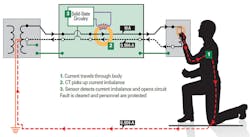5 ways to retrofit motors for electrical safety
While fatal, work-related electrical injuries have declined, electrical injuries at processing plants have remained relatively flat. Plant workers routinely work on motors and pumps, placing them at risk for electric shock and arc-flash hazards. Besides paying medical bills and liability, companies lose valuable production time.
According to the U.S. Bureau of Labor Statistics, the two biggest electrical hazards in industrial situations are electric shock and arc flash (which is capable of producing third-degree burns, blindness, crushing a worker’s chest or smashing equipment). The Electrical Safety Foundation International reported 2,480 non-fatal electrical injuries and 134 electrical fatalities in the U.S. in 2015.
Electricity-related incidents that injure or kill workers, or destroy equipment are expensive – in more ways than one.
Having strict safety practices and procedures written into company policy and drilled into employees is necessary. But to avoid the high human and capital costs associated with industrial electrical hazards, the best course may be to design safety into the plant’s electrical systems from the start. This will help save lives, save money, and protect the investment in pumps and motors.
Following are five easy retrofits to electrical systems that help processing facility managers safeguard workers and equipment, comply with safety codes and standards, and adapt to electrical trends.
1. Upgrade to intelligent motor-protection relays
It used to be that only expensive motors were protected by full-featured relays, while smaller motors had only basic overload relay protection. As the cost of microprocessors has fallen, it is now easy and affordable to install intelligent relays on almost any motor or pump. These relays protect in two ways. First, they shut off power in dangerous conditions. Second, they monitor and report conditions so that workers can prevent small headaches from becoming big safety hazards.
Motors are subject to multiple problems – for example, overloads, jammed loads, a phase imbalance in motor power, and ground faults. They are also expensive to replace; if damaged, downtime spent on repairing or replacing motors may be far more costly. Traditional electromechanical motor overload relays based on heating elements and bimetallic components will respond to only a few of the cited problems with motors, but modern motor relays can detect and respond to all of them and more.
Some electronic motor protection relays can detect all the above conditions, as well as earth leakage current, ground faults, undercurrent, motor overheating (via a dynamic thermal model of the motor), overvoltage, undervoltage, reversed phase sequence, phase loss and voltage imbalance. Some can even detect changes in power factor, making them able to detect loss of flow caused by a blocked inlet or dry well. Typically, such relays communicate the problems that they detect (as well as the present state of the motor) to the control system via standard plant networks.
It is also important to use a relay with a maintenance setting to increase protection while a worker is in the panel. A maintenance setting on the motor or feeder protection relay increases worker protection by configuring it to trip at its instantaneous setting.
2. Keep the panel door closed with Bluetooth-enabled devices
Troubleshooting a problem with a motor often requires a worker to put on personal protective equipment, open the electrical panel for that motor and read the fault codes on the motor protection relay. Opening the cabinet exposes the worker to the risk of shock and perhaps electrical arc flash.
Thanks to the increasing use of smartphones for work, detection and sharing of real-time potential hazards is easier and more efficient – and possibly life-saving.
Some motor protection relays can communicate to a technician’s smartphone via a Bluetooth connection. Workers can read fault codes on their smartphones and configure a relay up to 30 feet away, never opening the panel door, and staying safe from electrical hazards.
Relays such as the Littelfuse MP8000 smart motor-protection relay work with an app that provides all the information about the relay and the circuit in which it is connected.
3. Use current-limiting fuses
Certain types of fuses, called current-limiting fuses, will open quickly enough to limit the amount of current going to an electrical fault in a motor control center. This can prevent or minimize the damage and prevent worse issues such as fire and explosions. Additionally, it avoids costly downtime and motor refurbishment costs.
Because the total energy released in an arc flash depends on both the current available and the time during which the arc continues (It), anything that can reduce the duration of the arc is helpful. For example, at sufficient current (20x rating), a current-limiting fuse will open in less than 8.3 milliseconds (ms) (1/2 a cycle at 60 Hz), preventing the current from reaching its potential peak.
Most modern fuse types are current-limiting. The problem comes from fuses used in legacy equipment because maintenance workers tend to replace a fuse with the same type that was there before, without considering the benefits of upgrading to a newer fuse type. New indicating fuses are available that show when the fuse has opened. This avoids the safety risk of a worker needing to probe the electrical cabinet with a voltmeter to identify which fuse or fuses must be replaced.
Current limiting fuses are also a simple way to increase the short-circuit current rating (SCCR) of a panel. SCCR is determined by the corresponding rating of the “weakest link,” or lowest-rated device, within the panel. But if the panel uses current-limiting fuses in the feeder circuit, its SCCR may be greater than that of the lowest-rated component, which means it is often possible to increase the SCCR of a panel by replacing just a few components with current-limiting fuses.
4. Install arc flash relays
Installing current-limiting fuses alone is not always sufficient to stop the damage that an arc can cause. While it takes 20 times an overcurrent device’s normal rating to cause it to open in 10 ms or less, an arc will typically draw much less current, and can still do considerable damage before growing into a full-blown arc flash event. Consider that an arc welder delivering just 125 amps can easily weld 1/8-inch steel, and yet many overcurrent devices will not open at this level of current – or at least take several seconds to do so.
An arc flash is caused by shorting a high-energy (generally about 300 volts (V) or greater) conductor to ground or another conductor, which produces a searing burst of visible and invisible light as well as a powerful blast. In fact, arc flash is the second greatest danger facing plant electrical maintenance workers.
The easiest way to design arc-flash safety into an electrical panel is with an arc-flash relay. Such relays are small and easily retrofitted into switchgear, motor control centers and other electrical panels. An arc-flash relay will detect the light and send a trip signal to the breaker upstream before the arc flash can build to catastrophic levels.
An arc-flash relay is typically used in panels where voltages are greater than 300 V. It detects the light an arc flash gives off as it begins to develop and sends a trip signal to the circuit breaker in less than 1 ms. The circuit breaker will open in 30 to 50 ms, which is fast enough to prevent significant damage. Sometimes there is so little damage that it can take a little searching to determine what happened.
Generally, it is recommended to mount one or two light sensors per cubicle to cover all horizontal and vertical bus bars, breaker compartments, drawers, and anywhere that there is potential for an arc-fault. Threading a fiber-optic sensor through the cabinets and in areas where point-sensor coverage is uncertain results in complete coverage and an added level of redundancy.
5. Add an industrial GFCI
Water and process fluids are electrically conductive. Where electricity, moisture and people meet – such as in a submersible pump, mixer and similar process equipment – the risk of shock and electrocution increases. That is why bathrooms and kitchens are required to use ground-fault circuit interrupters (GFCI) outlets. GFCIs quickly open the circuit when they detect a ground fault. They are credited with saving thousands of lives.
A GFCI monitors the difference between current in the phase conductors going out to the load and returning through those conductors. Any difference indicates that current is returning through an unintended path (usually through ground and potentially through a person), and when such a current is detected, the GFCI rapidly shuts off the power. A GFCI differs from a ground fault relay in one vital aspect: A ground fault relay does not open the circuit directly, but triggers an upstream circuit breaker or contactor to open, which adds too much time to provide worker protection.
Merely 50 milliamps (mA) of current can put an adult human heart into fibrillation, with potentially fatal results. Even as low as 10 mA muscle clamping can prevent a person being shocked from being able to let go of the conductor. UL 943 Class A GFCIs trip between 4 and 6 mA (typically 5 mA) in part to remain below this threshold, and this has saved many lives. Unfortunately, under normal operating conditions, industrial leakage currents can be near or exceed 6 mA, making a household-type Class A GFCI impractical for industrial applications.
Recently, UL 943C has been developed in recognition of the need to offer a means of protecting industrial personnel from shock while acknowledging that industrial applications have unique challenges and risks. UL 943C creates two new classes of what are now called Special-Purpose GFCIs (SPGFCI), Classes C and D. SPGFCIs differ from household (Class A) units in several ways. Aside from the obvious – industrial packaging, operating voltage and availability in three-phase models – the trip level has been increased from 6 mA to 20 mA, providing more flexibility to industrial applications while still operating in the time required by the UL 943 trip curve for protecting personnel. Another key difference for SPGFCIs is that they monitor the ground conductor, and will trip if the ground conductor is discontinuous (i.e. the load loses the low-resistance path to ground provided in the electrical cable). This protects personnel from an ungrounded chassis that could potentially be at full-phase voltage, which is potentially hazardous.
It is worth noting that for some applications, 20 mA still may be too sensitive (particularly where variable frequency drives are employed). A device similar to a SPGFCI that is not intended for personnel safety, but for equipment protection, is called an Equipment Ground-Fault Protection Device (EGFPD). EGFPDs operate on the same UL 943 curve as other GFCIs but have adjustable sensitivity, typically as low as Class A (6 mA) but also all the way up to 100 mA. This can allow for sensitivity to be adjusted to the next highest level above the base leakage current, providing the safest possible environment for personnel in cases where personnel protection at 20 mA is not achievable. EGFPDs typically also monitor the ground conductor, but this monitoring is not required.
Industrial GFCIs, like the other safety devices described, are relatively easy and affordable to retrofit into existing electrical equipment. Anyone concerned with electrical safety in a plant should be empowered to take a closer look at how well their workers are protected, and at what other changes can be made in the facility to provide even better protection.
Dave Scheuerman is technical training manager at Littelfuse.




